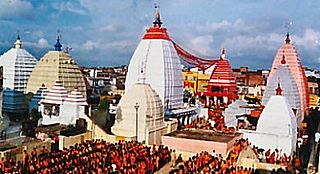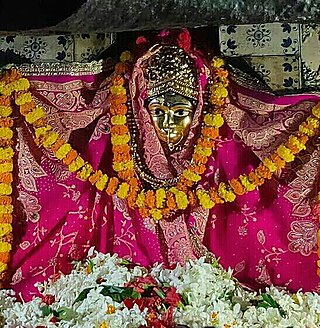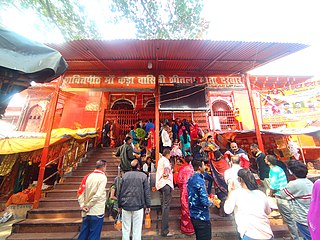
Muktinath is an ancient Vishnu temple located in Mustang, Nepal. The temple of Muktinath, known as 'the lord of liberation', is sacred to both Hindus and Buddhists whom they worship as an abode of Hindu deity Vishnu and Buddhist deity Avalokiteśvara respectively. Located in the Muktinath valley at the foot of the Thorong La mountain pass, it is one of the world's highest temples at an altitude of 3,800 meters. The temple is given a status of one of the 108 Divya Desams of Hinduism and the only Divya Desam located outside India. It is also one of the 51 Shakti Pitha, associated with the head of goddess Sati. The temple complex is known as Mukti Kshetra, which literally means "the place of liberation (moksha)" and is one of the Char Dham in Nepal.

The Shakta pithas, Shakti pithas or Sati pithas are significant shrines and pilgrimage destinations in Shaktism, the mother goddess denomination in Hinduism. The shrines are dedicated to various forms of Adi Shakti. Various Puranas such as Srimad Devi Bhagavatam state the existence of a varying number of 51, 52, 64 and 108 Shakta pithas of which 18 are named as Astadasha Maha (major) in medieval Hindu texts.

Bhadrakali is a Hindu goddess. She is considered to be the auspicious and fortunate form of Adi Shakti who protects the good, known as Bhadra.

Saptashrungi or Saptashringi is a site of Hindu pilgrimage situated 60 kilometres (37 mi) from Nashik in Indian state of Maharashtra. According to Hindu traditions, the goddess Saptashrungi Nivasini dwells within the seven mountain peaks. It is located in Nanduri, Kalwan taluka, a small village near Nashik in India. The Marathas and some Hindu tribes have worshipped the goddess from a long time and some worship her as their kuldaivat. There are 510 steps to climb the gad. Devotees visit this place in large numbers every day. The temple is also known popularly as one of the "three and half Shakti Peethas" of Maharashtra. The temple is also one among the 51 Shakti Peethas located on the Indian subcontinent and is a location where one of Sati's limbs, her right arm is reported to have fallen. Its half shaktipeeth among three and half shaktipeeth of Maharashtra.

The Vishalakshi Temple, also known as Vishalakshi Gauri Mandir and Vishalakshi Amman Kovil, is a Hindu temple dedicated to the goddess Vishalakshi at Mir Ghat on the banks of the Ganges at Varanasi. It was Built and Maintained by Nattukottai Nagarathar a mercantile community from Tamil Nadu

Tarapith is a town and Hindu pilgrimage site located in Rampurhat subdivision of Birbhum district of the Indian state of West Bengal. The town is particularly known for its Tantric temple and its adjoining Hindu crematory ground. The Tantric Hindu temple is dedicated to the goddess Tara.

Chintpurni is a small town in the Una district of Himachal Pradesh about 40 km north of Una, not far from the border with the Indian state of Punjab. The elevation is about 977 meters. It is home to the Maa Chintpurni Temple which is a major pilgrimage site as one of the Shakti Peethas in India. The Hindu genealogy registers at Chintpurni, Himachal Pradesh are kept here. North of Chintpurni are the western Himalayas. Chintpurni lies within the much lower Shiwalik range.

Guhyeshwari Temple, also spelled Guheswari or Gujeshwari, is one of the revered holy temples in Kathmandu, Nepal. This temple is dedicated to Guhyeshwari or Adi Shakti. The temple is also a Shakti Peetha and it's about 1 km east of Pashupatinath Temple and is located on the southern bank of the Bagmati River. It is an important pilgrimage destination for Hindus, especially for Tantric worshipers. King Pratap Malla renovated this temple in the 17th century.

Baidyanath Temple, also known as Baba Baidyanath Dham, is a Hindu temple dedicated to Shiva. It is located in Deoghar, in the Santhal Parganas division of the Indian state of Jharkhand. The temple complex comprises the central shrine of Baba Baidyanath along with 21 additional temples. It is significant to the Hindu sects of Shaivism as this temple is referred to as one of the twelve Jyotirlingas.

The Mangla Gauri temple in Shakti Peetham, Gaya, Bihar, India has been mentioned in Padma Purana, Vayu Purana and Agni Purana and Devi Bhagvata Purana and Markandeya Purana in other scriptures and tantric works. This temple is among the eighteen maha shaktipeeth. The present temple dates back to the 15th century. The shrine is dedicated to Sati or the Mother Goddess in the predominantly Vaishnavite pilgrimage center of Gaya. Mangalagauri is worshipped as the Goddess of benevolence. This temple constitutes a Shakti Peeth — where it is believed that a part of the body - breast of Mata Sati fell according to scriptures of extremely ancient Hindu divine history. Here Sati is worshipped in the form of a breast, a symbol of nourishment. It is believed that whoever comes to Maa Durga with his wishes and prayers, returns successfully with all of prayers and wishes come true.

Jeshoreshwari Kali Temple is a famous Hindu temple in Bangladesh, dedicated to the goddess Kali. The temple is located in Ishwaripur, a village in Shyamnagar upazila of Satkhira. The name "Jeshoreshwari" means "Goddess of Jeshore". The Prime Minister of India Shri Narendra Modi visited this temple in 2021.

Jayanti Devi Temple lies at Jayanti Majri village hillock, which is 15 km from Chandigarh in Mohali district of Punjab.

Sri Bhramaramba Mallikarjuna Temple or Srisailam Temple is a Hindu temple dedicated to the deities Shiva and Parvati, located at Srisailam in the Indian state of Andhra Pradesh. It is significant to the Hindu sects of both Shaivism and Shaktism as this temple is referred to as one of the twelve Jyotirlingas of Shiva and as one of the eighteen Shakti Pithas, centres of the Hindu Goddess. Shiva is worshiped as Mallikarjuna, and is represented by the lingam. His consort Parvati is depicted as Bhramaramba.
Shri Shri Mahalakshmi Bhairabi Griba Maha Peetha is one of the Shakta pithas, at Joinpur village, Dakshin Surma, near Gotatikar, 3 km south-east of Sylhet town, Bangladesh. The Hindu Goddess Sati's neck fell here. The Goddess is worshipped as Mahalakshmi and the Bhairav form is Sambaranand.
In religion and spirituality, a pilgrimage is a very long journey or search of great moral significance. Sometimes, it is a journey to a sacred area or shrine of importance to innate faith. Members of every major religion participate in pilgrimages. A person who makes such a journey is called a pilgrim.
Sugandha Shaktipeeth, a temple of the Goddess Sunanda, is located in the village of Shikarpur, 10 miles north of Barisal, in Bangladesh. This Hindu temple is one of the Shakti Peethas.

The temple of Attahas, is believed to be one of the 51 Shakti Peethas at which the body parts and jewelry of the Hindu goddess Shakti fell to Earth. The goddess is so large that the lower lip is about 15 to 18 feet wide. The temple is a site of Hindu pilgrimage throughout the year. December is a particularly popular time for visitors to picnic at the site.

Maa Tara Chandi Temple is a Hindu temple dedicated to Maa Shakti or Maa Durga, located in Sasaram, Bihar, India. It is one of the 51 Shakti Peetha.

Sheetla Devi Temple is a Hindu temple dedicated to the mother goddess Shitala, located in Kara, Uttar Pradesh. It is one of the 51 Shakti Peethas in Shaktism denomination of Hinduism. The deity of the temple is regarded as the Kuldevi of gurgaon.


















